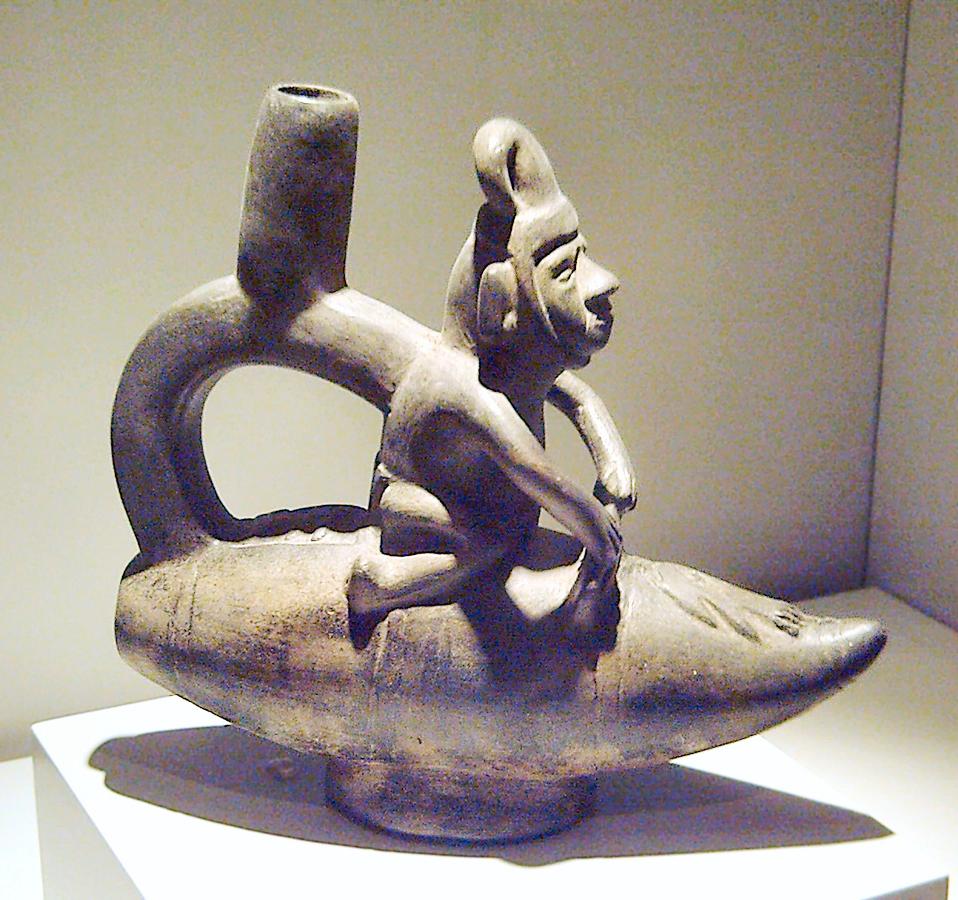
Great South American Native American Civilizations: The Chimu (c1100-1476 AD)

Figure 1.--This Chimú vessel was not overly functional, but shows the Chimu connection with the sea. It accurately depicts a fisherman on a 'caballitos de totora' (reed watercraft), more famous for use on Lake Titicaca. It is basically dated to the Chimu era. Chimu ceramics were usually, but not always stained black and polishd. There is a playfulness oe whimsy with some Chimu ceramics that we do not note with other Native American work. Museum of the Americas (Madrid).
|
|
The Chimu or Chimor Empire dominated the coast of Peru after the coastal people began to recover from the enviroment disater that undermined the Wari. Some archaeologists believe they may be related to Moche, rising from the remanents of the Moche. Early Chimu pottery is similar to that of the Moche. The Chimu, like the Wari, were a war-like people. They began the conquests building their empire (about 1100 AD). The Chimu eventually controlled much of the coast of northern Peru. The Chimu Empire was much smaller than the Wari Empire at its height and more dependant on the sea. They were masters of irrigation. They constructed elaborate irrigation works which fed water running diown from the Andes to irrigate the arid coastal lowlands. The center of the Chimu state was Chan Chan along the coast north of Lima. A 20-mile canal carried water from the Chicama Valley to Chan Chan which was thus able to support a population of some 70,000 people. They also utilized marine resources using the same reed boats that were developed for use in Lake Titicaca (figure 1). Minchancamon was the last Chimu emperor. He conquuered the Sican in the north. Then war broke out with the Inca in the south (1462). It is unclear as to who attacked who, but war between the two military states was inevitable once they came into contact. The war with the Inca lasted over a decade. The Inca developed the strategy of diverting canal waters from besiged cities. The Inca eventually conquered the Chimu (1475-76). This put the Chimu under great pressure. Archaeologistse have found evidence of the greatest instance of child sacrifice ever found. At Las Llamas north of Trujillo they found skeletons of some 140 children (ages 5-14 years). The Aztecs were know to sacrifice much larger numbers, but they sacrifuced mostly adult males. Preserved footprints reveal how the children were dragged to the site where they were rutuallu sacrificed with knife blows to the sternum.
The lead archeologist writes, “They were possibly offering the gods the most important thing they had as a society, and the most important thing is children because they represent the future.” It is not known what occassioned the event. It could have been adverse weather conditions and drought. But given the approximate date (about 1470), it could have been connected with the Inca war. The Inca absorbed the entire Chimu Empire, their largest single conquest. Thus the coast of Peru becme part of the Tawantinsuyu community which until the fall of the Chimu had been a basically Andean empire. It is at this time that the Inca moved their capital to Cuzco.
Sources
Prieto, Gabriel. National University of Trujillo. "The 550 year old Chimú site in Las Llamas, Peru is world’s largest child sacrifice site," Anthropology.net (April 28, 2018).
CIH

Navigate the Children in History Website:
[Return to the Main Great South Americam Native American civilizations page]
[Return to the Main Great Native American civilizations page]
[Return to the Main South American tribes page]
[Return to the Main Native American page]
[Introduction]
[Biographies]
[Chronology]
[Climatology]
[Clothing]
[Disease and Health]
[Economics]
[Geography]
[History]
[Human Nature]
[Law]
[Nationalism]
[Presidents]
[Religion]
[Royalty]
[Science]
[Social Class]
[Bibliographies]
[Contributions]
[FAQs]
[Glossaries]
[Images]
[Links]
[Registration]
[Tools]
[Children in History Home]
Created: 5:13 AM 7/6/2018
Last updated: 5:13 AM 7/6/2018



